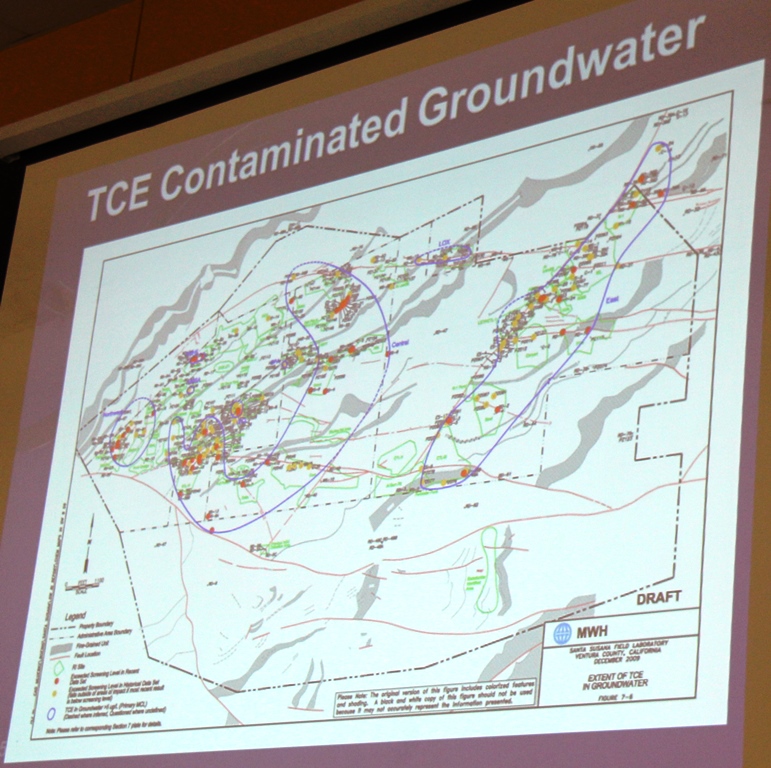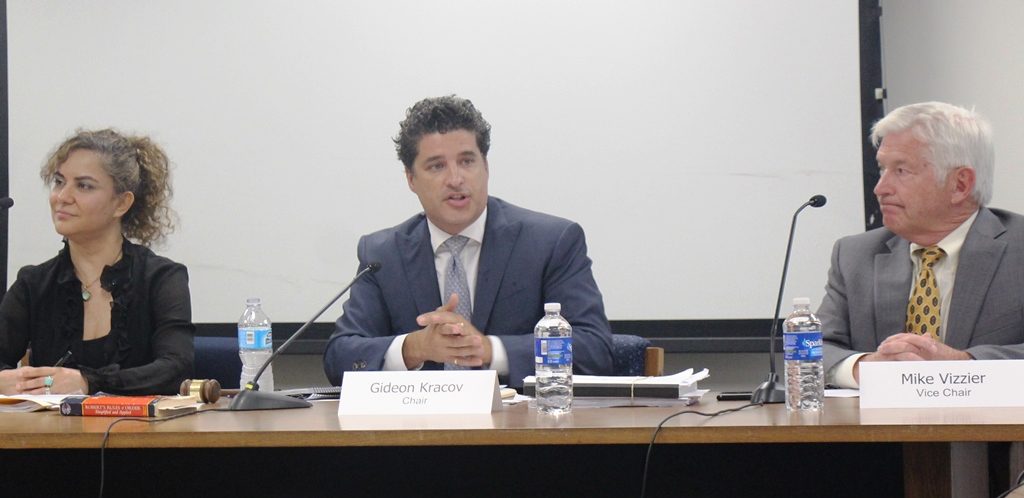23. Page 9/59: “US EPA’s data indicate that contaminants related to the Radiological Areas of Interest did not migrate off site.”
[ER NOTE: FALSE – The US EPA report did no such thing. It was an onsite report, not offsite. DTSC uses the word “indicate” about this report that didn’t even test Brandeis-Bardin for radiation and chemical contamination. Furthermore, DTSC deliberately left out more current DOE data that shows that Area IV contamination has indeed migrated onto Brandeis-Bardin property as noted in 3D and 10. This greenwashing DTSC ‘white paper’ cites the wrong report to make a major erroneous claim and excludes the recent DOE data that shows just the opposite.]
24. Page 10/59: “[P]eople at Brandeis Bardin are not expected to be at risk from exposure to radionuclides from Area IV.”
[ER NOTE: MEANINGLESS YET REVEALING – “Not expected” by whom exactly? DTSC? AJU? This statement doesn’t say people are not at risk with certainty. The wording here, and throughout the ‘white paper’ seems polished by an attorney in its obliqueness.]
25. Page 12/59: “In other words, while the FAL exceedances represent ·results that may be detected, we cannot accept that the data were adequately quantified at a level that we can compare to a regulatory threshold and make a decision of exceedance. We have less tolerance for analytical uncertainty when making such decisions.”
[ER NOTE: DISQUALIFYING EXCEEDANCES – This truly amazing statement says, basically, that any exceedance isn’t valid. Then it claims it has less tolerance for analytical uncertainty but only when the hits are higher than the already skewed FALs. This is a fourth pillar of prevarication: Anything registering hot has to be a false measurement.]

26. Pages 12/59: “Based on this and other lines of evidence, the US EPA results do not indicate contaminant migration off-site from the NBZ [Northern Buffer Zone].”
[ER NOTE: FALSE ASSUMPTION LEADING TO FALSE CONCLUSION – Carefully crafting super-sized word salads justifying phony conclusions has reached a peak here. The only problem is that it isn’t true as was clearly shown in government reports ignored by DTSC as well as EnviroReporter.com‘s 13-year-long Brandeis-Bardin investigation.]
27. Pages 13/59: “To be protective, the potential false positive can be compared to a risk-based screening level in order to evaluate whether it warrants additional attention.
“Risk-based screening levels (RBSLs) can be useful for simple comparison, but they were not originally intended for use with point-by-point comparisons. RBSLs are not cleanup standards and should not be applied as such. They can be used to help identify areas, contaminants, and conditions, which may require further attention; however, just because a sample exceeds a risk based screening level does not automatically designate a site as contaminated.”
[ER NOTE: KNOWINGLY USING WRONG METHOD – DTSC introduces its fifth pillar of prevarication: Introducing another admittedly wrong set of standards to rejigger those pesky high hits of radiation and chemicals.
The department pulled this bait and switch bad science at an April 12, 2016 public meeting explaining away elevated hits of strontium-90 snaking their way down a drainage from Area IV through the NBZ and into Brandeis-Bardin. DTSC said that the hits were under the RBSL of 3.85 picocuries per gram (pCi/g) for Sr-90 when that is hundreds of times less protective than the current EPA Residential Preliminary Remediation Goal of 0.00121 pCi/g. In fact, DTSC’s false RBSL standard was 3,182 times higher (less protective) than Sr-90’s BTV.]

28. Pages 15-16/59: “Single point exceedances of Cs-137 and Sr-90 (not co-located) were identified in 1992 at Campsite 1, and a single point exceedance of Sr-90 was identified in the Campsite 1 Drainage during the 1994 sampling.”
[ER NOTE: TRUE, BUT… – That “single point exceedance,” a nifty way of implying an abnormal reading when it was actually the only reading for Cs-137 which was a significant 0.38 pCi/g making this “exceedance” 96.9 percent higher than background. Under the Agreements on Consent (AOCs) with NASA and DOE, DTSC requires cleanup of radiation and chemicals to background but at Brandeis-Bardin, no such cleanup is in the offing.
But, much more importantly, DTSC didn’t inspect this “Campsite 1” area that EnviroReporter.com determined might very well be in the immediate area of the gushing goo it verified and authenticated as gurgling away in 2004, 2005, 2006, 2007 and 2014 as seen in this YouTube video called Sludge from Rocketdyne. Yet somehow DTSC and AJU have managed to miss this spot in all their reports trumpeting that SSFL goo hasn’t impacted Brandeis-Bardin. Perhaps some of the hundreds of kids staying at Camp Alonim this summer will amble up Meier Canyon and find this spot and take a few photos or videos they would like to share with us.
EnviroReporter.com didn’t miss this hard-to-miss spot’s suspect looking soil’s test results from 2004. As reported in “Brandeis-Bardin’s Toxic Denial”: “The peak 2004 Pu-239/240 sample exceeded its BTV by 55.2 percent. This extremely toxic, cancer-causing radioisotope produced during a nuclear reaction was precisely 21.6 percent higher than the “Maximum Value Detected” (MDV) for the radionuclide found in Area IV in the EPA’s October 2011 Final Radiological Background Study Report – SSFL [PDF page 282/286; 16.5 MB].”
The water next to Campsite I was also worrisome as reported. Sr-90 measured over double both the Los Angeles and national averages and beta radiation came in “over double the national average in drinking water supplies derived by data provided by the National Research Council (US) Safe Drinking Water Committee. Beta radiation is often associated with man-made radionuclides like Cs-137 and Sr-90.”
Though we reported in “Brandeis-Bardin’s Toxic Denial” that “Tritium came in at double background according to H-3 levels cited in an April 21, 1996 Brandeis-Bardin crop testing report recently released by AJU in response to the KNBC I-Team investigation LA’s Nuclear Secret which included Brandeis-Bardin’s pollution issues,” EnviroReporter.com has obtained information from a 2014 Lawrence Livermore National Laboratory report, posted on the California State Water Resources Control Board website, that says it is actually zero.
Maps of the state in California GAMA Special Study: Geostatistical analysis of groundwater age and other noble gas derived parameters in California groundwater show no ‘background’ tritium in groundwater under the Simi Valley area where Brandeis-Bardin is. This strongly suggests the source of the tritium coming out of the Campsite 1 area pipe in 2005 – 34.6 pCi/L – is from neighboring SSFL.
It’s not like DTSC didn’t know this information when they dated their report May 2, 2017. “Brandeis-Bardin’s Toxic Denial” came out over three weeks earlier April 6, 2017, replete with all this information backed up on the spot. DTSC repeatedly visits EnviroReporter.com. This is DTSC’s sixth pillar of prevarication: Ignoring the findings from EnviroReporter.com‘s 13-year-long investigation of Brandeis-Bardin.]
29. Page 18/59: “This resulted in revised Background Threshold Values (two standard deviations on the mean) for Cs-137 (0.349 pCi/g) and Sr-90 (0.127 pCi/g).”
[ER NOTE: CORRUPTED BTVs – Cesium-137’s surface soil BTV is 0.193 pCi/g according the US EPA. So Tetra Tech’s “revised Background Threshold Values” are 80.8 percent higher. Strontium-90’s combined (surface and subsurface) soil BTV is 0.0735 pCi/g making DTSC’s inflated Sr-90 72.8 percent higher. Tetra Tech was AJU’s contractor that performed a 2016 Brandeis-Bardin study.]












Recent Comments